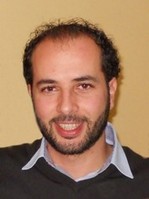C. Ampelli
Peoples > Associate Professors
 Claudio Ampelli obtained his PhD from the Faculty of Engineering of the University of Pisa (Italy) in 2005, working on the development of chemical reactors for highly reactive systems with emphasis on industrial sensors. After his PhD, he has joined as a Research Associate to the Laboratory of Catalysis for Sustainable Production and Energy (CASPE), acquiring a wide experience in the field of electrochemical engineering, especially in the development of nano-engineered electrodes and (photo-)electrocatalytic devices. In 2010 he became a Junior Researcher at the University of Messina (Italy) and in 2016 he has been promoted to the position of Senior Researcher. Since 2010, he has also been an Assistant Professor in “Chemical Plants and Technologies” and a member of the Teaching Committee of the PhD School in Engineering and Chemistry of Materials and Constructions. He has supervised 1 PhD thesis, 2 master theses, 6 bachelor theses and several postgraduate and post-doc students projects. During the last years, he has been involved in about 15 highly multisciplinary research projects funded by both national and international institutions, coordinating the research activities of many work packages. He has been the co-author of about 50 publications in scientific journals and 90 contributions to international and national conferences (with more than 20 oral communications and 3 keynote/invited lectures). His recent research interests are focused on the development and design of novel nano-dimensional catalysts and chemical devices for a sustainable production of energy, fuels and chemicals. The processes under investigation are: i) water photoelectrolysis and photo-reforming of organic waste streams for H2 production; ii) (photo-)electrocatalytic reduction of CO2 to liquid fuels (in liquid- or gas-phase); iii) electrocatalytic synthesis of ammonia from N2 and H2O.
Claudio Ampelli obtained his PhD from the Faculty of Engineering of the University of Pisa (Italy) in 2005, working on the development of chemical reactors for highly reactive systems with emphasis on industrial sensors. After his PhD, he has joined as a Research Associate to the Laboratory of Catalysis for Sustainable Production and Energy (CASPE), acquiring a wide experience in the field of electrochemical engineering, especially in the development of nano-engineered electrodes and (photo-)electrocatalytic devices. In 2010 he became a Junior Researcher at the University of Messina (Italy) and in 2016 he has been promoted to the position of Senior Researcher. Since 2010, he has also been an Assistant Professor in “Chemical Plants and Technologies” and a member of the Teaching Committee of the PhD School in Engineering and Chemistry of Materials and Constructions. He has supervised 1 PhD thesis, 2 master theses, 6 bachelor theses and several postgraduate and post-doc students projects. During the last years, he has been involved in about 15 highly multisciplinary research projects funded by both national and international institutions, coordinating the research activities of many work packages. He has been the co-author of about 50 publications in scientific journals and 90 contributions to international and national conferences (with more than 20 oral communications and 3 keynote/invited lectures). His recent research interests are focused on the development and design of novel nano-dimensional catalysts and chemical devices for a sustainable production of energy, fuels and chemicals. The processes under investigation are: i) water photoelectrolysis and photo-reforming of organic waste streams for H2 production; ii) (photo-)electrocatalytic reduction of CO2 to liquid fuels (in liquid- or gas-phase); iii) electrocatalytic synthesis of ammonia from N2 and H2O.ORCID ID: orcid.org/0000-0001-7048-976X